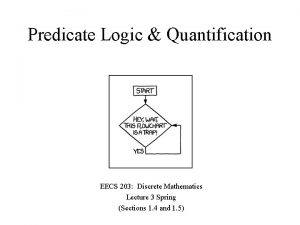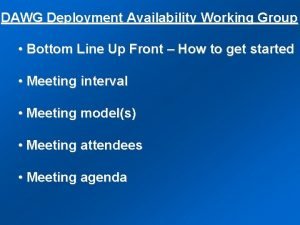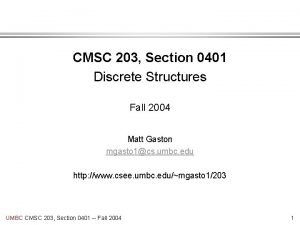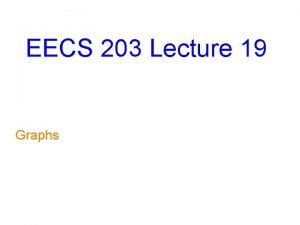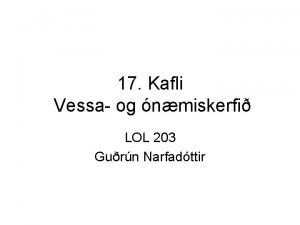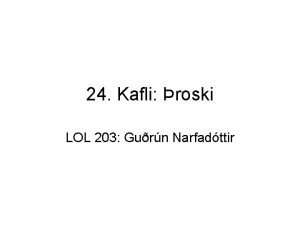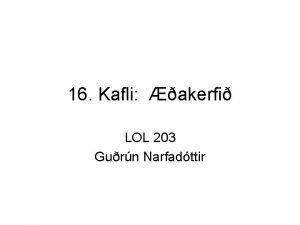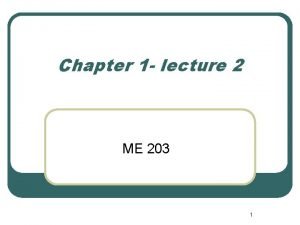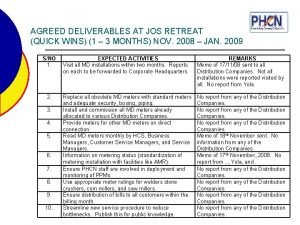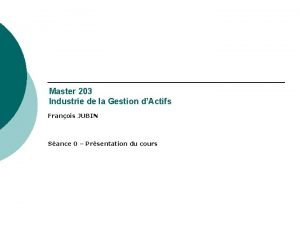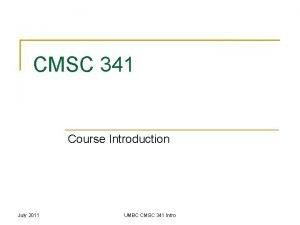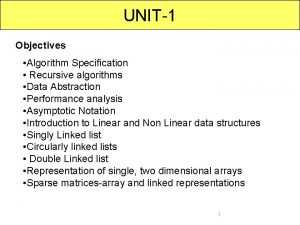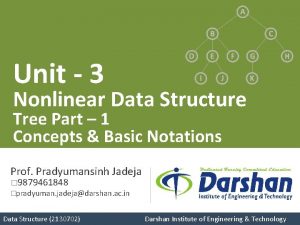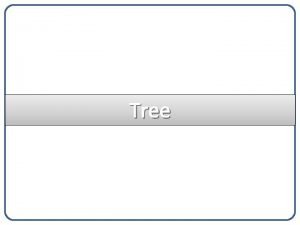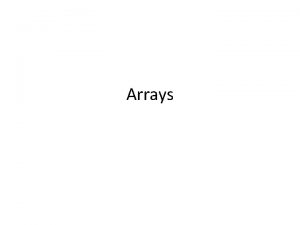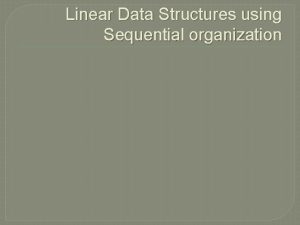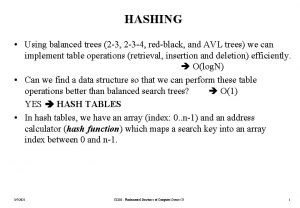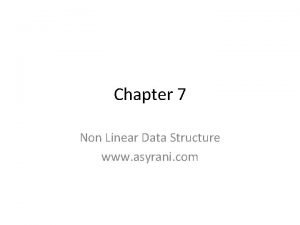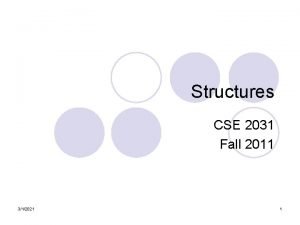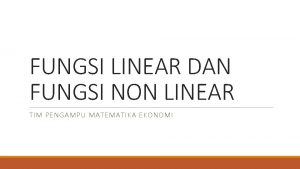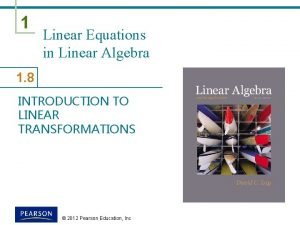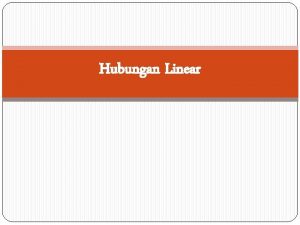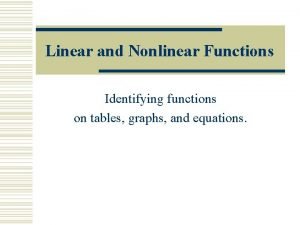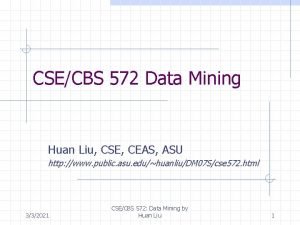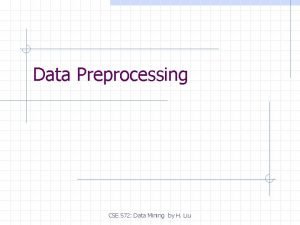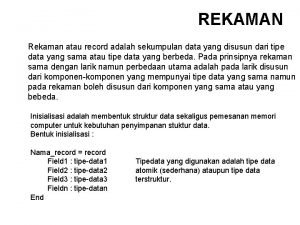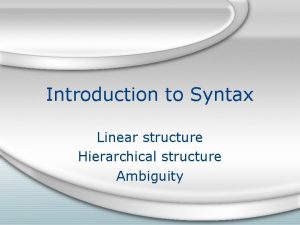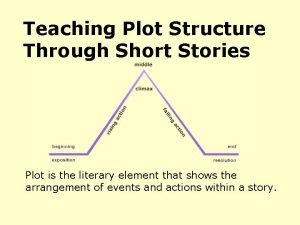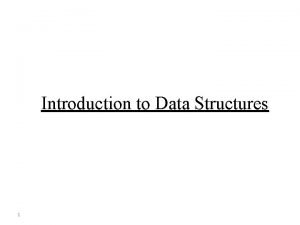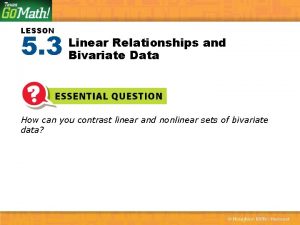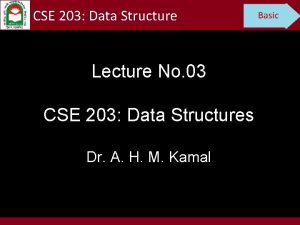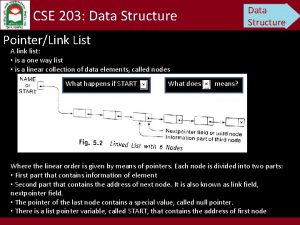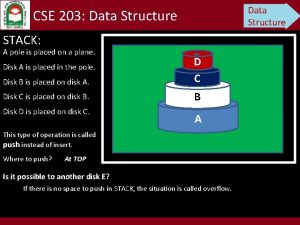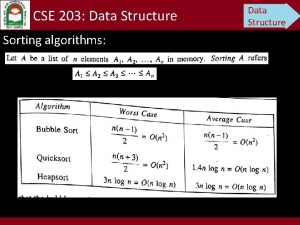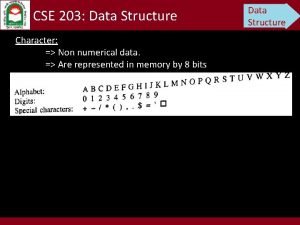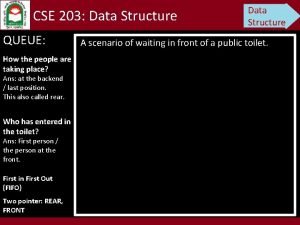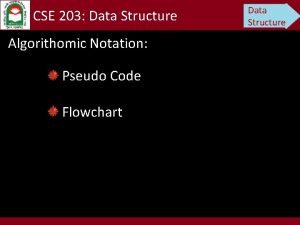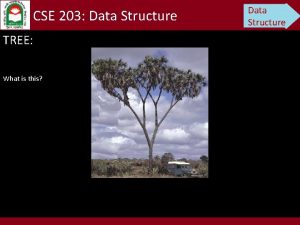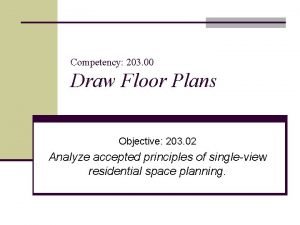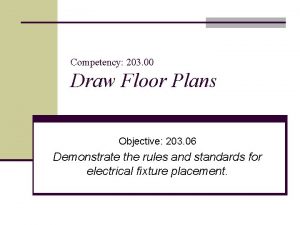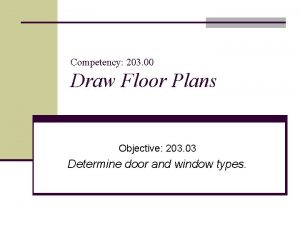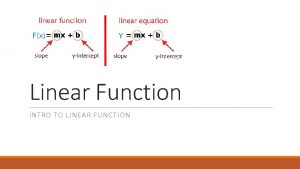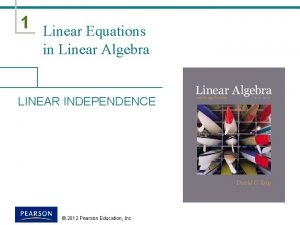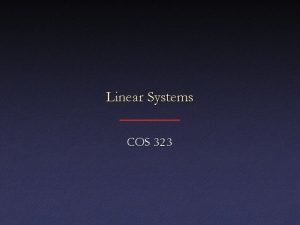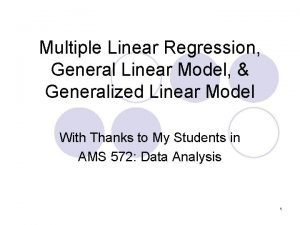Data Structure CSE 203 Data Structure Linear Elements





















































































- Slides: 85

Data Structure CSE 203: Data Structure Linear: Elements form a sequence, i. e. , liner list Array: Elements in sequential memory locations Link list: Relationship between elements by means of pointer. Nonlinear: Elements do not form a sequence Tree Graph These two will be defined later.

Data Structure CSE 203: Data Structure Linear: Elements form a sequence, i. e. , liner list Array: Elements in sequential memory locations Link list: Relationship between elements by means of pointer. Nonlinear: Elements do not form a sequence Tree Graph These two will be defined later. Operations that are performed on liner data structure.

Data Structure CSE 203: Data Structure Linear: Elements form a sequence, i. e. , liner list Array: Elements in sequential memory locations Link list: Relationship between elements by means of pointer. Our target is to explain it first. Nonlinear: Elements do not form a sequence Tree Graph These two will be defined later.

Data Structure CSE 203: Data Structure Linear: Elements form a sequence, i. e. , liner list Array: Elements in sequential memory locations Liner Array Multidimensional Array Link list: Relationship between elements by means of pointer. Nonlinear: Elements do not form a sequence Tree Graph These two will be defined later.

Data Structure CSE 203: Data Structure Linear Array: This one dimensional array. List of finite n homogenous data elements. Representation style

Data Structure CSE 203: Data Structure Linear Array: This one dimensional array. List of finite n homogenous data elements. Elements 15 12 Index 1 2 0 3 11 20 11 4 5 6 9 7 Elements 15 12 Index 1 2 0 3 A 20 11 4 5 6 9 7 28 33 8 9 D 8 33 9

Data Structure CSE 203: Data Structure Linear Array: This one dimensional array. List of finite n homogenous data elements. Elements 15 12 Index 1 2 0 3 11 20 11 4 5 6 9 7 Elements 15 12 Index 1 2 0 3 A 20 11 4 5 6 9 7 28 33 8 9 D 8 33 9 Not array

Data Structure CSE 203: Data Structure Linear Array: This one dimensional array. List of finite n homogenous data elements. Elements 15 12 Index 1 2 0 3 11 20 11 4 5 6 9 7 28 33 8 9 Lower bound (LB) Upper bound (UB) : Smallest index : Largest index Length=UB-LB+1

CSE 203: Data Structure Linear Array: This one dimensional array. Data Structure

Data Structure CSE 203: Data Structure Linear Array: This one dimensional array. Sold Auto 15 12 50 Year 1932 1933 … 11 … 20 … 11 … 19 28 33 … 1983 1984 Lower bound (LB) Upper bound (UB) Length=UB-LB+1=1984 -1932+1=53

CSE 203: Data Structure Linear Array: . LA 1000 1001 1002 1003 Data Structure Representation in memory • Memory of the computer is simply sequence of address. • Hence, linear array holds a block of contiguous memory cells. • Let LA is a linear array • Start at memory location 1000, that is, first data at 1000 • Second data at 1001 • Third data at 1002 • and so on. LA[K]= Element in the Kth location of the array LA. Here, K ϵ {1000, 1001, 1002, 1003, …, …} LOC(LA[K})= Address of the element LA[K] in the array LA. Computer keeps track only of the first element of the array LA Address of the first element of the array LA=

CSE 203: Data Structure Linear Array: . LA 1000 1001 1002 1003 Representation in memory Address of the first element of the array LA= Loc(LA[K])=Base(LA)+K-LB) Where w is the number of words per memory cell. Data Structure

CSE 203: Data Structure Linear Array: Representation in memory Address of the first element of the array LA= Here w=4 Data Structure

CSE 203: Data Structure Linear Array: . LA 1 2 3 4 N Data Structure Traversing Accessing and processing of each element of array LA • exactly once and • sequentially Algorithm 1: Here LA is a linear array with lower bound LB upper bound UB. The algorithm traverses LA by applying PROCESS to each element of LA.

CSE 203: Data Structure Linear Array: . LA 1 2 3 4 N Data Structure Traversing Accessing and processing of each element of array LA • exactly once and • sequentially Algorithm 1: Here LA is a linear array with lower bound LB upper bound UB. The algorithm traverses LA by applying PROCESS to each element of LA. K=LB=1

Data Structure CSE 203: Data Structure Linear Array: . LA 1 2 3 4 N Traversing Accessing and processing of each element of array LA • exactly once and • sequentially Algorithm 1: Here LA is a linear array with lower bound LB upper bound UB. The algorithm traverses LA by applying PROCESS to each element of LA. K=1 If N=10, UB=10 Then K≤UB means 1 ≤ 10 and thus, it is true

Data Structure CSE 203: Data Structure Linear Array: . LA 1 2 3 4 N Traversing Accessing and processing of each element of array LA • exactly once and • sequentially Algorithm 1: Here LA is a linear array with lower bound LB upper bound UB. The algorithm traverses LA by applying PROCESS to each element of LA. K=1 If N=10, UB=10 Then K≤UB means 1 ≤ 10 and thus, it is true

Data Structure CSE 203: Data Structure Linear Array: . LA 1 2 3 4 N Traversing Accessing and processing of each element of array LA • exactly once and • sequentially Algorithm 1: Here LA is a linear array with lower bound LB upper bound UB. The algorithm traverses LA by applying PROCESS to each element of LA. K=1 K=K+1 means K=2 If N=10, UB=10 Then K≤UB means 1 ≤ 10 and thus, it is true

Data Structure CSE 203: Data Structure Linear Array: . LA 1 2 3 4 N Traversing Accessing and processing of each element of array LA • exactly once and • sequentially Algorithm 1: Here LA is a linear array with lower bound LB upper bound UB. The algorithm traverses LA by applying PROCESS to each element of LA. K=2 K≤UB means 2 ≤ 10 and thus, it is true

Data Structure CSE 203: Data Structure Linear Array: . LA 1 2 3 4 N Traversing Accessing and processing of each element of array LA • exactly once and • sequentially Algorithm 1: Here LA is a linear array with lower bound LB upper bound UB. The algorithm traverses LA by applying PROCESS to each element of LA. K=2 K≤UB means 2 ≤ 10 and thus, it is true

Data Structure CSE 203: Data Structure Linear Array: . LA 1 2 3 4 N Traversing Accessing and processing of each element of array LA • exactly once and • sequentially Algorithm 1: Here LA is a linear array with lower bound LB upper bound UB. The algorithm traverses LA by applying PROCESS to each element of LA. This way it will continue and consider that the repetition is done for 9 times, that is K=10 K=2 K=K+1 means K=3 K≤UB means 2 ≤ 10 and thus, it is true

Data Structure CSE 203: Data Structure Linear Array: . LA 1 2 3 4 N Traversing Accessing and processing of each element of array LA • exactly once and • sequentially Algorithm 1: Here LA is a linear array with lower bound LB upper bound UB. The algorithm traverses LA by applying PROCESS to each element of LA. K=10 10 ≤ 10 and thus, it is true

Data Structure CSE 203: Data Structure Linear Array: . LA 1 2 3 4 N Traversing Accessing and processing of each element of array LA • exactly once and • sequentially Algorithm 1: Here LA is a linear array with lower bound LB upper bound UB. The algorithm traverses LA by applying PROCESS to each element of LA. K=10 10 ≤ 10 and thus, it is true

Data Structure CSE 203: Data Structure Linear Array: . LA 1 2 3 4 N Traversing Accessing and processing of each element of array LA • exactly once and • sequentially Algorithm 1: Here LA is a linear array with lower bound LB upper bound UB. The algorithm traverses LA by applying PROCESS to each element of LA. K=10 K=K+1 means K=11 10 ≤ 10 and thus, it is true

Data Structure CSE 203: Data Structure Linear Array: . LA 1 2 3 4 N Traversing Accessing and processing of each element of array LA • exactly once and • sequentially Algorithm 1: Here LA is a linear array with lower bound LB upper bound UB. The algorithm traverses LA by applying PROCESS to each element of LA. K=11 11 ≤ 10 and thus, it is false

Data Structure CSE 203: Data Structure Linear Array: . LA 1 2 3 4 N Traversing Accessing and processing of each element of array LA • exactly once and • sequentially Algorithm 1: Here LA is a linear array with lower bound LB upper bound UB. The algorithm traverses LA by applying PROCESS to each element of LA. K=11 11 ≤ 10 and thus, it is false

CSE 203: Data Structure Linear Array: . LA 1 2 3 4 Data Structure Traversing Algorithm 1: Here LA is a linear array with lower bound LB upper bound UB. The algorithm traverses LA by applying PROCESS to each element of LA. N Alternate Algorithm

Data Structure CSE 203: Data Structure Linear Array: Traversing Algorithm Traverse . SL Roll CGPA 1 3. 5 3. 25 2 3. 5 3 4 3. 75 3. 9 N 3. 00 Is it possible to use traversing algorithm (Algorithm Traverse) in counting the number of students in JKKNIU whose CGPA is greater than 3. 5 in 2018? Algorithm CGPA: Let SL of size N is an array of student list. Its index means the roll no of a student and the value of each index contains their CGPA till 2018. Use T to count the number of students whose CGPA>=3. 5. Here, LB=1 and UB=N. Step 1: T=0 [Initialization] Step 2: Repeat for K=LB to UB Step 3: If SL[K]>=3. 5 then T=T+1; [End of loop] Step 4: Return;

Data Structure CSE 203: Data Structure Linear Array: Traversing Algorithm Traverse . SL Roll CGPA 1 3. 5 3. 25 2 3. 5 3 4 3. 75 3. 9 N 3. 00 Let results of all the departments are stored in SL sequentially and the Dept’s LB (DLB) and Dept’s UB (DUB) of each dept is known. How to process for a specific dept? Algorithm CGPA: Let SL of size N is an array of student list. Its index means the roll no of a student and the value of each index contains their CGPA till 2018. Use T to count the number of students whose CGPA>=3. 5. Here, LB=1 and UB=N. Step 1: Step 2: Step 3: Step 4: T=0 [Initialization] Read the value of DLB and DUB Repeat for K=DLB to DUB If SL[K]>=3. 5 then T=T+1; [End of loop] Step 5: Return;

CSE 203: Data Structure Linear Array: Insertion and Deletion Scenario 1: Simply adding at the end of the array Data Structure

CSE 203: Data Structure Linear Array: Insertion and Deletion Scenario 1: Simply adding at the end of the array Scenario 2: Insertion and deletion in/from a sorted list. Data Structure

CSE 203: Data Structure Linear Array: . 1 10 2 12 3 11 4 15 5 21 6 22 7 19 8 20 N 14 LA Data Structure Insertion and Deletion Algorithm INSERT (LA, N, K, ITEM) Here LA is a linear array with N elements and 1≤K≤N The algorithm inserts an element ITEM into the Kth position in LA. Step 1: Set J: =N Step 2: Repeat Steps 3 and 4 while J≥K //Move J to Nth elements to their next position and start it from the last Step 3: Set LA[J+1]=La[J] Step 4: Set J=J-1 Step 5: Set LA[K]=ITEM Step 6: Set N=N+1 Step 7: Exit

CSE 203: Data Structure Linear Array: . 1 10 2 12 3 11 4 15 5 21 6 22 7 19 8 20 N 14 LA Data Structure Insertion and Deletion Algorithm INSERT (LA, N, K, ITEM) Here LA is a linear array with N elements and 1≤K≤N The algorithm inserts an element ITEM into the Kth position in LA. Step 1: Set J: =N While executing Step 2: Repeat Steps 3 and 4 while J≥K //Move J to Nth elements to their next position and start it from the last Step 3: Set LA[J+1]=La[J] Step 4: Set J=J-1 Step 5: Set LA[K]=ITEM N=9 Step 6: Set N=N+1 J=9 Step 7: Exit For example K=7

CSE 203: Data Structure Linear Array: . 1 10 2 12 3 11 4 15 5 21 6 22 7 19 8 20 N 14 LA Data Structure Insertion and Deletion Algorithm INSERT (LA, N, K, ITEM) Here LA is a linear array with N elements and 1≤K≤N The algorithm inserts an element ITEM into the Kth position in LA. Step 1: Set J: =N Step 2: Repeat Steps 3 and 4 while J≥K While executing //Move J to Nth elements to their next position and start it from the last Step 3: Set LA[J+1]=La[J] Step 4: Set J=J-1 Step 5: Set LA[K]=ITEM N=9 Step 6: Set N=N+1 J=9 Step 7: Exit K=7 J ≥K means 9 ≥ 7 is true

CSE 203: Data Structure Linear Array: . 1 10 2 12 3 11 4 15 5 21 6 22 7 19 8 20 JN 14 LA Data Structure Insertion and Deletion Algorithm INSERT (LA, N, K, ITEM) Here LA is a linear array with N elements and 1≤K≤N The algorithm inserts an element ITEM into the Kth position in LA. Step 1: Set J: =N Step 2: Repeat Steps 3 and 4 while J≥K //Move J to Nth elements to their next position and start it from the last Step 3: Set LA[J+1]=La[J] While executing Step 4: Set J=J-1 Step 5: Set LA[K]=ITEM N=9 Step 6: Set N=N+1 J=9 Step 7: Exit K=7 J+1 J ≥K means 9 ≥ 7 is true

CSE 203: Data Structure Linear Array: . 1 10 2 12 3 11 4 15 5 21 6 22 7 19 8 20 JN 14 LA Data Structure Insertion and Deletion Algorithm INSERT (LA, N, K, ITEM) Here LA is a linear array with N elements and 1≤K≤N The algorithm inserts an element ITEM into the Kth position in LA. Step 1: Set J: =N Step 2: Repeat Steps 3 and 4 while J≥K //Move J to Nth elements to their next position and start it from the last Step 3: Set LA[J+1]=La[J] While executing Step 4: Set J=J-1 Step 5: Set LA[K]=ITEM N=9 Step 6: Set N=N+1 J=9 Step 7: Exit K=7 J+1 14 J ≥K means 9 ≥ 7 is true

CSE 203: Data Structure Linear Array: . 1 10 2 12 3 11 4 15 5 21 6 22 7 19 8 20 JN 14 LA Data Structure Insertion and Deletion Algorithm INSERT (LA, N, K, ITEM) Here LA is a linear array with N elements and 1≤K≤N The algorithm inserts an element ITEM into the Kth position in LA. Step 1: Set J: =N Step 2: Repeat Steps 3 and 4 while J≥K //Move J to Nth elements to their next position and start it from the last Step 3: Set LA[J+1]=La[J] Step 4: Set J=J-1 While executing Step 5: Set LA[K]=ITEM N=9 Step 6: Set N=N+1 J=9 -1=8 Step 7: Exit K=7 J+1 14 J ≥K means 9 ≥ 7 is true

CSE 203: Data Structure Linear Array: . LA 1 10 2 12 3 11 4 15 5 21 6 22 7 19 J 8 20 N 14 J+1 Data Structure Insertion and Deletion Algorithm INSERT (LA, N, K, ITEM) Here LA is a linear array with N elements and 1≤K≤N The algorithm inserts an element ITEM into the Kth position in LA. Step 1: Set J: =N Step 2: Repeat Steps 3 and 4 while J≥K //Move J to Nth elements to their next position and start it from the last Step 3: Set LA[J+1]=La[J] Step 4: Set J=J-1 While executing Step 5: Set LA[K]=ITEM N=9 Step 6: Set N=N+1 J=9 -1=8 Step 7: Exit K=7 14 J ≥K means 9 ≥ 7 is true

CSE 203: Data Structure Linear Array: . LA 1 10 2 12 3 11 4 15 5 21 6 22 7 19 J 8 20 N 14 J+1 Data Structure Insertion and Deletion Algorithm INSERT (LA, N, K, ITEM) Here LA is a linear array with N elements and 1≤K≤N The algorithm inserts an element ITEM into the Kth position in LA. Step 1: Set J: =N Step 2: Repeat Steps 3 and 4 while J≥K While executing //Move J to Nth elements to their next position and start it from the last Step 3: Set LA[J+1]=La[J] Step 4: Set J=J-1 Step 5: Set LA[K]=ITEM N=9 Step 6: Set N=N+1 J=9 -1=8 Step 7: Exit K=7 14 J ≥K means 8 ≥ 7 is true

CSE 203: Data Structure Linear Array: . LA 1 10 2 12 3 11 4 15 5 21 6 22 7 19 J 8 20 N 14 J+1 Data Structure Insertion and Deletion Algorithm INSERT (LA, N, K, ITEM) Here LA is a linear array with N elements and 1≤K≤N The algorithm inserts an element ITEM into the Kth position in LA. Step 1: Set J: =N Step 2: Repeat Steps 3 and 4 while J≥K //Move J to Nth elements to their next position and start it from the last Step 3: Set LA[J+1]=La[J] While executing Step 4: Set J=J-1 Step 5: Set LA[K]=ITEM N=9 Step 6: Set N=N+1 J=9 -1=8 Step 7: Exit K=7 14 J ≥K means 8 ≥ 7 is true

CSE 203: Data Structure Linear Array: . LA 1 10 2 12 3 11 4 15 5 21 6 22 7 19 J 8 20 N 20 J+1 Data Structure Insertion and Deletion Algorithm INSERT (LA, N, K, ITEM) Here LA is a linear array with N elements and 1≤K≤N The algorithm inserts an element ITEM into the Kth position in LA. Step 1: Set J: =N Step 2: Repeat Steps 3 and 4 while J≥K //Move J to Nth elements to their next position and start it from the last Step 3: Set LA[J+1]=La[J] While executing Step 4: Set J=J-1 Step 5: Set LA[K]=ITEM N=9 Step 6: Set N=N+1 J=9 -1=8 Step 7: Exit K=7 14 J ≥K means 8 ≥ 7 is true

CSE 203: Data Structure Linear Array: . LA 1 10 2 12 3 11 4 15 5 21 6 22 7 19 J 8 20 N 20 J+1 Data Structure Insertion and Deletion Algorithm INSERT (LA, N, K, ITEM) Here LA is a linear array with N elements and 1≤K≤N The algorithm inserts an element ITEM into the Kth position in LA. Step 1: Set J: =N Step 2: Repeat Steps 3 and 4 while J≥K //Move J to Nth elements to their next position and start it from the last Step 3: Set LA[J+1]=La[J] Step 4: Set J=J-1 While executing Step 5: Set LA[K]=ITEM N=9 Step 6: Set N=N+1 J=8 -1=7 Step 7: Exit K=7 14 J ≥K means 8 ≥ 7 is true

CSE 203: Data Structure Linear Array: . LA 1 10 2 12 3 11 4 15 5 21 6 22 J 7 19 J+1 8 20 N 20 Data Structure Insertion and Deletion Algorithm INSERT (LA, N, K, ITEM) Here LA is a linear array with N elements and 1≤K≤N The algorithm inserts an element ITEM into the Kth position in LA. Step 1: Set J: =N Step 2: Repeat Steps 3 and 4 while J≥K //Move J to Nth elements to their next position and start it from the last Step 3: Set LA[J+1]=La[J] Step 4: Set J=J-1 While executing Step 5: Set LA[K]=ITEM N=9 Step 6: Set N=N+1 J=8 -1=7 Step 7: Exit K=7 14 J ≥K means 8 ≥ 7 is true

CSE 203: Data Structure Linear Array: . LA 1 10 2 12 3 11 4 15 5 21 6 22 J 7 19 J+1 8 20 N 20 Data Structure Insertion and Deletion Algorithm INSERT (LA, N, K, ITEM) Here LA is a linear array with N elements and 1≤K≤N The algorithm inserts an element ITEM into the Kth position in LA. Step 1: Set J: =N Step 2: Repeat Steps 3 and 4 while J≥K While executing //Move J to Nth elements to their next position and start it from the last Step 3: Set LA[J+1]=La[J] Step 4: Set J=J-1 Step 5: Set LA[K]=ITEM N=9 Step 6: Set N=N+1 J=7 Step 7: Exit K=7 14 J ≥K means 7 ≥ 7 is true

CSE 203: Data Structure Linear Array: . LA 1 10 2 12 3 11 4 15 5 21 6 22 J 7 19 J+1 8 20 N 20 Data Structure Insertion and Deletion Algorithm INSERT (LA, N, K, ITEM) Here LA is a linear array with N elements and 1≤K≤N The algorithm inserts an element ITEM into the Kth position in LA. Step 1: Set J: =N Step 2: Repeat Steps 3 and 4 while J≥K //Move J to Nth elements to their next position and start it from the last Step 3: Set LA[J+1]=La[J] While executing Step 4: Set J=J-1 Step 5: Set LA[K]=ITEM N=9 Step 6: Set N=N+1 J=7 Step 7: Exit K=7 14 J ≥K means 7 ≥ 7 is true

CSE 203: Data Structure Linear Array: . LA 1 10 2 12 3 11 4 15 5 21 6 22 J 7 19 J+1 8 19 N 20 Data Structure Insertion and Deletion Algorithm INSERT (LA, N, K, ITEM) Here LA is a linear array with N elements and 1≤K≤N The algorithm inserts an element ITEM into the Kth position in LA. Step 1: Set J: =N Step 2: Repeat Steps 3 and 4 while J≥K //Move J to Nth elements to their next position and start it from the last Step 3: Set LA[J+1]=La[J] While executing Step 4: Set J=J-1 Step 5: Set LA[K]=ITEM N=9 Step 6: Set N=N+1 J=7 Step 7: Exit K=7 14 J ≥K means 7 ≥ 7 is true

CSE 203: Data Structure Linear Array: . LA 1 10 2 12 3 11 4 15 5 21 6 22 J 7 19 J+1 8 19 N 20 Data Structure Insertion and Deletion Algorithm INSERT (LA, N, K, ITEM) Here LA is a linear array with N elements and 1≤K≤N The algorithm inserts an element ITEM into the Kth position in LA. Step 1: Set J: =N Step 2: Repeat Steps 3 and 4 while J≥K //Move J to Nth elements to their next position and start it from the last Step 3: Set LA[J+1]=La[J] Step 4: Set J=J-1 While executing Step 5: Set LA[K]=ITEM N=9 Step 6: Set N=N+1 J=7 -1=6 Step 7: Exit K=7 14 J ≥K means 7 ≥ 7 is true

CSE 203: Data Structure Linear Array: . LA 1 10 2 12 3 11 4 15 5 21 J 6 22 J+1 7 19 8 19 N 20 Data Structure Insertion and Deletion Algorithm INSERT (LA, N, K, ITEM) Here LA is a linear array with N elements and 1≤K≤N The algorithm inserts an element ITEM into the Kth position in LA. Step 1: Set J: =N Step 2: Repeat Steps 3 and 4 while J≥K //Move J to Nth elements to their next position and start it from the last Step 3: Set LA[J+1]=La[J] Step 4: Set J=J-1 While executing Step 5: Set LA[K]=ITEM N=9 Step 6: Set N=N+1 J=7 -1=6 Step 7: Exit K=7 14 J ≥K means 7 ≥ 7 is true

CSE 203: Data Structure Linear Array: . LA 1 10 2 12 3 11 4 15 5 21 J 6 22 J+1 7 19 8 19 N 20 Data Structure Insertion and Deletion Algorithm INSERT (LA, N, K, ITEM) Here LA is a linear array with N elements and 1≤K≤N The algorithm inserts an element ITEM into the Kth position in LA. Step 1: Set J: =N Step 2: Repeat Steps 3 and 4 while J≥K While executing //Move J to Nth elements to their next position and start it from the last Step 3: Set LA[J+1]=La[J] Step 4: Set J=J-1 Step 5: Set LA[K]=ITEM N=9 Step 6: Set N=N+1 J=6 Step 7: Exit K=7 14 J ≥K means 6 ≥ 7 is False

Data Structure CSE 203: Data Structure Linear Array: . LA 1 10 2 12 3 11 4 15 5 21 6 22 7 19 8 19 N 20 Insertion and Deletion Algorithm INSERT (LA, N, K, ITEM) Here LA is a linear array with N elements and 1≤K≤N The algorithm inserts an element ITEM into the Kth position in LA. Step 1: Set J: =N Step 2: Repeat Steps 3 and 4 while J≥K //Move J to Nth elements to their next position and start it from the last Step 3: Set LA[J+1]=La[J] Step 4: Set J=J-1 Step 5: Set LA[K]=ITEM While executing ITEM=18 N=9 Step 6: Set N=N+1 J=6 Step 7: Exit K=7 14 J ≥K means 6 ≥ 7 is False

Data Structure CSE 203: Data Structure Linear Array: . LA 1 10 2 12 3 11 4 15 5 21 6 22 7 18 8 19 N 20 Insertion and Deletion Algorithm INSERT (LA, N, K, ITEM) Here LA is a linear array with N elements and 1≤K≤N The algorithm inserts an element ITEM into the Kth position in LA. Step 1: Set J: =N Step 2: Repeat Steps 3 and 4 while J≥K //Move J to Nth elements to their next position and start it from the last Step 3: Set LA[J+1]=La[J] Step 4: Set J=J-1 Step 5: Set LA[K]=ITEM While executing ITEM=18 N=9 Step 6: Set N=N+1 J=6 Step 7: Exit K=7 14 J ≥K means 6 ≥ 7 is False

Data Structure CSE 203: Data Structure Linear Array: . LA 1 10 2 12 3 11 4 15 5 21 6 22 7 18 8 19 N 20 Insertion and Deletion Algorithm INSERT (LA, N, K, ITEM) Here LA is a linear array with N elements and 1≤K≤N The algorithm inserts an element ITEM into the Kth position in LA. Step 1: Set J: =N Step 2: Repeat Steps 3 and 4 while J≥K //Move J to Nth elements to their next position and start it from the last Step 3: Set LA[J+1]=La[J] Step 4: Set J=J-1 Step 5: Set LA[K]=ITEM=18 N=9+1=10 Step 6: Set N=N+1 While executing J=6 Step 7: Exit K=7 14 J ≥K means 6 ≥ 7 is False

Data Structure CSE 203: Data Structure Linear Array: . 1 10 2 12 3 11 4 15 5 21 6 22 7 18 8 19 9 20 LA Insertion and Deletion Algorithm INSERT (LA, N, K, ITEM) Here LA is a linear array with N elements and 1≤K≤N The algorithm inserts an element ITEM into the Kth position in LA. Step 1: Set J: =N Step 2: Repeat Steps 3 and 4 while J≥K //Move J to Nth elements to their next position and start it from the last Step 3: Set LA[J+1]=La[J] Step 4: Set J=J-1 Step 5: Set LA[K]=ITEM=18 N=10 Step 6: Set N=N+1 While executing J=6 Step 7: Exit K=7 N 14 J ≥K means 6 ≥ 7 is False

Data Structure CSE 203: Data Structure Linear Array: . 1 10 2 12 3 11 4 15 5 21 6 22 7 18 8 19 9 20 LA Insertion and Deletion Algorithm INSERT (LA, N, K, ITEM) Here LA is a linear array with N elements and 1≤K≤N The algorithm inserts an element ITEM into the Kth position in LA. Step 1: Set J: =N Step 2: Repeat Steps 3 and 4 while J≥K //Move J to Nth elements to their next position and start it from the last Step 3: Set LA[J+1]=La[J] Step 4: Set J=J-1 Step 5: Set LA[K]=ITEM=18 N=10 Step 6: Set N=N+1 J=6 Step 7: Exit While executing K=7 N 14 J ≥K means 6 ≥ 7 is False

CSE 203: Data Structure Linear Array: Data Structure Insertion and Deletion Algorithm INSERT: Algorithm INSERT (LA, N, K, ITEM) Here LA is a linear array with N elements and 1≤K≤N The algorithm inserts an element ITEM into the Kth position in LA. Step 1: Set J: =N Step 2: Repeat Steps 3 and 4 while J≥K Step 3: Set LA[J+1]=La[J] Step 4: Set J=J-1 Step 5: Set LA[K]=ITEM Step 6: Set N=N+1 Step 7: Exit C Program of Algorithm INSERT int INSERT(int LA, int N, int K, int ITEM) { int J; J=N-1; //Step 1 while(J≥K) //Step 2 { LA[J+1]=LA[J]; //Step 3 J=J-1; //Step 4 } LA[K]=ITEM; //Step 5 N=N-1; //Step 6 for(int I=0; I<N; I++) printf(“%d, “, LA[I]); return N; //Step 7 }

CSE 203: Data Structure Linear Array: . 1 10 2 12 3 11 4 15 5 21 6 22 7 19 8 20 N 14 LA Data Structure Insertion and Deletion Algorithm DELETE (LA, N, K, ITEM) Here LA is a linear array with N elements and 1≤K≤N The algorithm deletes Kth element from LA. Step 1: Set ITEM=LA[K] Step 2: Print the value of ITEM Step 3: Repeat for J=K to N-1 Step 4: Set LA[J]=La[J+1] Step 5: Set N=N-1 Step 6: Exit

CSE 203: Data Structure Linear Array: . 1 10 2 12 3 11 4 15 5 21 6 22 7 19 8 20 N 14 LA Data Structure Insertion and Deletion Algorithm DELETE (LA, N, K, ITEM) Here LA is a linear array with N elements and 1≤K≤N The algorithm deletes Kth element from LA. Step 1: Set ITEM=LA[K] While executing Step 2: Print the value of ITEM Step 3: Repeat for J=K to N-1 Step 4: Set LA[J]=La[J+1] Step 5: Set N=N-1 Step 6: Exit N=9 For example, K=7 ITEM=19

CSE 203: Data Structure Linear Array: . 1 10 2 12 3 11 4 15 5 21 6 22 7 19 8 20 N 14 LA Data Structure Insertion and Deletion Algorithm DELETE (LA, N, K, ITEM) Here LA is a linear array with N elements and 1≤K≤N The algorithm deletes Kth element from LA. Step 1: Set ITEM=LA[K] Step 2: Print the value of ITEM While executing Step 3: Repeat for J=K to N-1 Step 4: Set LA[J]=La[J+1] Step 5: Set N=N-1 Step 6: Exit N=9 For example, K=7 ITEM=19

CSE 203: Data Structure Linear Array: . 1 10 2 12 3 11 4 15 5 21 6 22 7 19 8 20 N 14 LA Data Structure Insertion and Deletion Algorithm DELETE (LA, N, K, ITEM) Here LA is a linear array with N elements and 1≤K≤N The algorithm deletes Kth element from LA. Step 1: Set ITEM=LA[K] Step 2: Print the value of ITEM Step 3: Repeat for J=K to N-1 While executing Step 4: Set LA[J]=La[J+1] Step 5: Set N=N-1 N=9 For example, K=7 Step 6: Exit ITEM=19 J=K=7 J ≤ N-1 is true

CSE 203: Data Structure Linear Array: . 1 10 2 12 3 11 4 15 5 21 6 22 J 7 19 J+1 8 20 N 14 LA Data Structure Insertion and Deletion Algorithm DELETE (LA, N, K, ITEM) Here LA is a linear array with N elements and 1≤K≤N The algorithm deletes Kth element from LA. Step 1: Set ITEM=LA[K] Step 2: Print the value of ITEM Step 3: Repeat for J=K to N-1 Step 4: Set LA[J]=La[J+1] While executing Step 5: Set N=N-1 Step 6: Exit N=9 K=7 ITEM=19 J=7

CSE 203: Data Structure Linear Array: . 1 10 2 12 3 11 4 15 5 21 6 22 J 7 20 J+1 8 20 N 14 LA Data Structure Insertion and Deletion Algorithm DELETE (LA, N, K, ITEM) Here LA is a linear array with N elements and 1≤K≤N The algorithm deletes Kth element from LA. Step 1: Set ITEM=LA[K] Step 2: Print the value of ITEM Step 3: Repeat for J=K to N-1 Step 4: Set LA[J]=La[J+1] While executing Step 5: Set N=N-1 Step 6: Exit N=9 K=7 ITEM=19 J=7

CSE 203: Data Structure Linear Array: . 1 10 2 12 3 11 4 15 5 21 6 22 J 7 20 J+1 8 20 N 14 LA Data Structure Insertion and Deletion Algorithm DELETE (LA, N, K, ITEM) Here LA is a linear array with N elements and 1≤K≤N The algorithm deletes Kth element from LA. Step 1: Set ITEM=LA[K] Step 2: Print the value of ITEM Step 3: Repeat for J=K to N-1 While executing Step 4: Set LA[J]=La[J+1] Step 5: Set N=N-1 N=9 Step 6: Exit K=7 ITEM=19 J=7+1=8

CSE 203: Data Structure Linear Array: . 1 10 2 12 3 11 4 15 5 21 6 22 7 20 J 8 20 N 14 J+1 LA Data Structure Insertion and Deletion Algorithm DELETE (LA, N, K, ITEM) Here LA is a linear array with N elements and 1≤K≤N The algorithm deletes Kth element from LA. Step 1: Set ITEM=LA[K] Step 2: Print the value of ITEM Step 3: Repeat for J=K to N-1 While executing Step 4: Set LA[J]=La[J+1] N=9 Step 5: Set N=N-1 K=7 Step 6: Exit ITEM=19 J=7+1=8 J ≤ N-1 is True

CSE 203: Data Structure Linear Array: . 1 10 2 12 3 11 4 15 5 21 6 22 7 20 J 8 20 N 14 J+1 LA Data Structure Insertion and Deletion Algorithm DELETE (LA, N, K, ITEM) Here LA is a linear array with N elements and 1≤K≤N The algorithm deletes Kth element from LA. Step 1: Set ITEM=LA[K] Step 2: Print the value of ITEM Step 3: Repeat for J=K to N-1 Step 4: Set LA[J]=La[J+1] While executing Step 5: Set N=N-1 Step 6: Exit N=9 K=7 ITEM=19 J=8

CSE 203: Data Structure Linear Array: . 1 10 2 12 3 11 4 15 5 21 6 22 7 20 J 8 14 N 14 J+1 LA Data Structure Insertion and Deletion Algorithm DELETE (LA, N, K, ITEM) Here LA is a linear array with N elements and 1≤K≤N The algorithm deletes Kth element from LA. Step 1: Set ITEM=LA[K] Step 2: Print the value of ITEM Step 3: Repeat for J=K to N-1 Step 4: Set LA[J]=La[J+1] While executing Step 5: Set N=N-1 Step 6: Exit N=9 K=7 ITEM=19 J=8

CSE 203: Data Structure Linear Array: . 1 10 2 12 3 11 4 15 5 21 6 22 7 20 J 8 14 N 14 J+1 LA Data Structure Insertion and Deletion Algorithm DELETE (LA, N, K, ITEM) Here LA is a linear array with N elements and 1≤K≤N The algorithm deletes Kth element from LA. Step 1: Set ITEM=LA[K] Step 2: Print the value of ITEM Step 3: Repeat for J=K to N-1 While executing Step 4: Set LA[J]=La[J+1] Step 5: Set N=N-1 Step 6: Exit N=9 K=7 ITEM=19 J=8+1=9

CSE 203: Data Structure Linear Array: . 1 10 2 12 3 11 4 15 5 21 6 22 7 20 J 8 14 N 14 J+1 LA Data Structure Insertion and Deletion Algorithm DELETE (LA, N, K, ITEM) Here LA is a linear array with N elements and 1≤K≤N The algorithm deletes Kth element from LA. Step 1: Set ITEM=LA[K] Step 2: Print the value of ITEM Step 3: Repeat for J=K to N-1 While executing Step 4: Set LA[J]=La[J+1] Step 5: Set N=N-1 N=9 Step 6: Exit K=7 ITEM=19 J=9 J ≤N-1 is False

CSE 203: Data Structure Linear Array: . 1 10 2 12 3 11 4 15 5 21 6 22 7 20 8 14 N 14 LA Data Structure Insertion and Deletion Algorithm DELETE (LA, N, K, ITEM) Here LA is a linear array with N elements and 1≤K≤N The algorithm deletes Kth element from LA. Step 1: Set ITEM=LA[K] Step 2: Print the value of ITEM Step 3: Repeat for J=K to N-1 Step 4: Set LA[J]=La[J+1] Step 5: Set N=N-1 While executing Step 6: Exit N=9 -1=8 K=7 ITEM=19 J=9

CSE 203: Data Structure Linear Array: . 1 10 2 12 3 11 4 15 5 21 6 22 7 20 N 14 14 LA Data Structure Insertion and Deletion Algorithm DELETE (LA, N, K, ITEM) Here LA is a linear array with N elements and 1≤K≤N The algorithm deletes Kth element from LA. Step 1: Set ITEM=LA[K] Step 2: Print the value of ITEM Step 3: Repeat for J=K to N-1 Step 4: Set LA[J]=La[J+1] Step 5: Set N=N-1 While executing Step 6: Exit N=10 K=7 ITEM=19 J=9 N=9 -1=8

CSE 203: Data Structure Linear Array: . 1 10 2 12 3 11 4 15 5 21 6 22 7 20 N 14 14 LA Data Structure Insertion and Deletion Algorithm DELETE (LA, N, K, ITEM) Here LA is a linear array with N elements and 1≤K≤N The algorithm deletes Kth element from LA. Step 1: Set ITEM=LA[K] Step 2: Print the value of ITEM Step 3: Repeat for J=K to N-1 Step 4: Set LA[J]=La[J+1] Step 5: Set N=N-1 Step 6: Exit While executing N=10 K=7 ITEM=19 J=9 N=9 -1=8

CSE 203: Data Structure Linear Array: Data Structure Insertion and Deletion Algorithm DELETE: Algorithm DELETE (LA, N, K, ITEM) Here LA is a linear array with N elements and 1≤K≤N The algorithm deletes Kth element from LA. Step 1: Set ITEM=LA[K] Step 2: Print the value of ITEM Step 3: Repeat for J=K to N-1 Step 4: Set LA[J]=La[J+1] Step 5: Set N=N-1 Step 6: Exit C Program of Algorithm DELETE int DELETE(int LA, int N, int K, int ITEM) { int J; ITEM=LA[K]; //Step 1 printf(“%d”, ITEM) //Step 2 for(J=K; J<N-1; J++) //Step 3 LA[J]=LA[J+1]; //Step 4 N=N-1; //Step 5 return N; //Step 6 }

CSE 203: Data Structure Linear Array: . 1 10 2 12 3 11 4 15 5 21 6 22 7 19 8 20 N 14 LA Data Structure Sorting Given an array LA. It contains N elements. The values of the elements are not stored in the array in any sorting order. Our task is to sort the elements in the array LA.

CSE 203: Data Structure Linear Array: . 1 10 2 12 3 11 4 15 5 21 6 22 7 19 8 20 N 14 LA Sorting Bubble Sort Strategy: Data Structure

Data Structure CSE 203: Data Structure Linear Array: . Sorting Bubble Sort Strategy: . LA 1 10 1 2 12 2 3 11 3 4 15 After doing that 4 5 21 5 6 22 6 7 19 8 20 N 14 7 8 N 22 Checking all N elements, move the largest one to upward index position and finally put it here. LA

CSE 203: Data Structure Linear Array: . . LA Sorting Data Structure Bubble Sort Strategy: LA . 1 10 1 1 2 12 2 2 3 11 3 3 4 15 4 5 21 5 5 6 22 6 6 7 19 8 20 N 14 7 8 N 22 After doing that After 1 st cycle Checking first N-1 elements, move the largest one to upward index position and finally put here the 2 nd highest. 4 7 8 21 N 22 LA

CSE 203: Data Structure Linear Array: . . LA Sorting LA . Data Structure Bubble Sort Strategy: LA . 1 10 1 1 1 2 12 2 3 11 3 3 4 15 4 4 4 5 21 5 5 5 6 22 6 6 7 19 8 20 N 14 7 8 N 22 7 8 21 N 22 After 1 st cycle After 2 nd cycle After doing that Checking first N-2 elements, move the largest one to upward index position and finally put here the 3 rd highest. 3 6 7 20 8 21 N 22 LA

CSE 203: Data Structure Linear Array: Sorting Data Structure

CSE 203: Data Structure Linear Array: Sorting Data Structure

CSE 203: Data Structure Linear Array: Sorting Data Structure

CSE 203: Data Structure Linear Array: Data Structure Searching refers to the operation of finding an ITEM in a location LOC in an array DATA. Output: Successful Unsuccessful The algorithm that one chooses depends on the way the information in the DATA is organized. Example: Linear search Binary search

CSE 203: Data Structure Linear Array: Searching O(n)=n Data Structure

Data Structure CSE 203: Data Structure Linear Array: Searching O(n)=└ log 2 n ┘

CSE 203: Data Structure Linear Array: Searching Two-dimensional array A of size m x n. Each element of the array is specified by A[J, K] where 1≤J ≤m, 1 ≤K ≤n Data Structure

CSE 203: Data Structure Linear Array: Searching Two-dimensional array A of size m x n. Each element of the array is specified by A[J, K] where 1≤J ≤m, 1 ≤K ≤n Memory Representation: Data Structure

CSE 203: Data Structure Linear Array: Searching Two-dimensional array A of size m x n. Each element of the array is specified by A[J, K] where 1≤J ≤m, 1 ≤K ≤n Data Structure
 Linear plot definition
Linear plot definition Rad 203
Rad 203 Eecs 203
Eecs 203 Fha 203h disaster loan
Fha 203h disaster loan Rad etx-203am
Rad etx-203am Rad etx-203ax configuration guide
Rad etx-203ax configuration guide Afi 10-203
Afi 10-203 Cmsc 203 umbc
Cmsc 203 umbc 456x203
456x203 Rad etx-203ax-dsl
Rad etx-203ax-dsl Embeded systems design
Embeded systems design Eet 203
Eet 203 Eet 203
Eet 203 Eecs 203
Eecs 203 Lol 203
Lol 203 Master203
Master203 1948 peugeot 203
1948 peugeot 203 250 hangi yüzlüğe yuvarlanır
250 hangi yüzlüğe yuvarlanır 203 fourgonnette
203 fourgonnette Lol 203
Lol 203 Lol 203
Lol 203 Dorm room 203
Dorm room 203 Un=9n-4 jika un=176 tentukan n
Un=9n-4 jika un=176 tentukan n Un=-3n+7 jika un=-203 tentukan n
Un=-3n+7 jika un=-203 tentukan n Etx-220a
Etx-220a Cpsc 203
Cpsc 203 State postulate
State postulate Financial aid office auburn university
Financial aid office auburn university Agreed deliverables
Agreed deliverables 952 203-0000
952 203-0000 Resource management guide 203
Resource management guide 203 Finc203
Finc203 Eet 203
Eet 203 Induction math
Induction math Master 203
Master 203 Cst 203
Cst 203 Eet 203
Eet 203 Cmsc 331
Cmsc 331 Lg bp 203
Lg bp 203 Static and dynamic queue in data structure
Static and dynamic queue in data structure What is linear data structure
What is linear data structure Linear data structure
Linear data structure Linear and nonlinear data structure
Linear and nonlinear data structure Linear and nonlinear data structure
Linear and nonlinear data structure Traversing linear array algorithm
Traversing linear array algorithm Representation of linear array in data structure
Representation of linear array in data structure Address calculation in data structure
Address calculation in data structure Double hash table
Double hash table Non linear data structure example
Non linear data structure example Cse lewis structure
Cse lewis structure Simple linear regression and multiple regression
Simple linear regression and multiple regression Contoh soal metode numerik biseksi dan penyelesaiannya
Contoh soal metode numerik biseksi dan penyelesaiannya Appropriate non linear text
Appropriate non linear text Contoh soal persamaan linear dan non linear
Contoh soal persamaan linear dan non linear Non linear pipeline processors
Non linear pipeline processors Types of linear multimedia
Types of linear multimedia Left-linear grammar
Left-linear grammar Perbedaan fungsi linier dan non linier
Perbedaan fungsi linier dan non linier Pengertian fungsi non linear
Pengertian fungsi non linear What is linear dependence and independence
What is linear dependence and independence Linear algebra linear transformation
Linear algebra linear transformation Koordinat lereng
Koordinat lereng Linear impulse and momentum
Linear impulse and momentum Persamaan simultan
Persamaan simultan Nonlinear table
Nonlinear table Linear or not
Linear or not Difference between linear and nonlinear equation
Difference between linear and nonlinear equation Nonlinear video editing
Nonlinear video editing Sistem persamaan linear metode numerik
Sistem persamaan linear metode numerik Closure properties of regular languages
Closure properties of regular languages Redação narrativa
Redação narrativa Data mining
Data mining Cse 572
Cse 572 Combines elements of linear and parallel process flows
Combines elements of linear and parallel process flows Which elements of a play are considered technical elements
Which elements of a play are considered technical elements Overhead allocation
Overhead allocation Hydrosulfuric acid
Hydrosulfuric acid Http //elements.wlonk.com/elements table.htm
Http //elements.wlonk.com/elements table.htm Literary elements in folktales
Literary elements in folktales Three elements of folktales
Three elements of folktales Contoh record
Contoh record Hierarchical structure syntax
Hierarchical structure syntax Plot and structure of a short story
Plot and structure of a short story Elementary data organization in data structure
Elementary data organization in data structure Lesson 5.3 linear relationships and bivariate data
Lesson 5.3 linear relationships and bivariate data Transformasi linier
Transformasi linier


